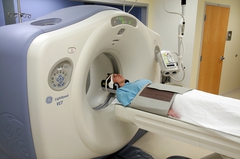Computed Tomography (CT) Scan
 CT Scan
CT (computed tomography), sometimes called CAT scan, uses special x-ray equipment to obtain image data from different angles around the body and then uses computer processing of the information to show a cross-section of body tissues and organs.
CT Scan
CT (computed tomography), sometimes called CAT scan, uses special x-ray equipment to obtain image data from different angles around the body and then uses computer processing of the information to show a cross-section of body tissues and organs.
OSF Saint James - John W. Albrecht Medical Center offers area residents one of the very latest CT imaging technology. Our state-of-the-art, low dose, GE VCT 64 slice scanner is among the best CT technology available today.
We want our patients receive the highest quality CT image with the lowest radiation dose possible. OSF Saint James utilizes advanced reconstruction technology to remove image noise, allowing clinicians to decrease radiation doses to the patient by up to 40 percent.
In addition, for all routine CT procedures, the multi-slice scanner and digital technology gives OSF Saint James the capability perform specialty procedures such as CT angiography including cardiac CT angiography and cardiac calcium scanning.
How should I prepare for the CAT scan?
You should wear comfortable, loose-fitting clothing for your CT exam. Metal objects can affect the image, so avoid clothing with zippers and snaps.
You may also be asked to remove hairpins, jewelry, eyeglasses, hearing aids and any removable dental work, depending on the part of the body that is being scanned.
You may be asked not to eat or drink anything for one or more hours before the exam. Women should always inform their doctor or x-ray technologist if there is any possibility that they are pregnant.
What does the equipment look like?
During a CT scan, you lie on a table inside a large doughnut-shaped ring. An X-ray tube inside the machine rotates around your body and sends small doses of radiation through it at various angles.
A CT examination often requires the use of different contrast materials to enhance the visibility of certain tissues or blood vessels. The contrast material may be swallowed or injected through an IV directly into the blood stream depending on the type of examination.
Before administering the contrast material, the radiologist or technologist will have you fill out a screening form to assure that it is safe for you to have the contrast material injected into the IV.
If you have had a history of an allergy to a reactant requiring emergent intervention in the past and you have never had any contrast before, please notify the X-Ray department.
A CT examination usually takes fifteen to forty-five minutes.
What will I experience during the procedure?
CT scanning causes no pain, and today's faster scanners reduce the need to lie still for any length of time. Some patients find the taste of the contrast material mildly unpleasant but most can easily tolerate it.
A contrast material is commonly injected into a vein to better define the blood vessels and kidneys and to accentuate the appearance between normal and abnormal tissue in organs like the liver and spleen.
Some people report feeling a flush of heat and sometimes a metallic taste in the back of the mouth. These sensations usually disappear within a minute or two. Some people experience a mild itching sensation.
You will be alone in the room during the scan; however, the technologist can see, hear and speak with you at all times.
Who interprets the results and how do I get them?
A radiologist, who is a physician experienced in CT and other radiology examinations, will analyze the images and send a signed report with his or her interpretation to the patient's personal physician.
The personal physician's office will inform the patient on how to obtain their results.
